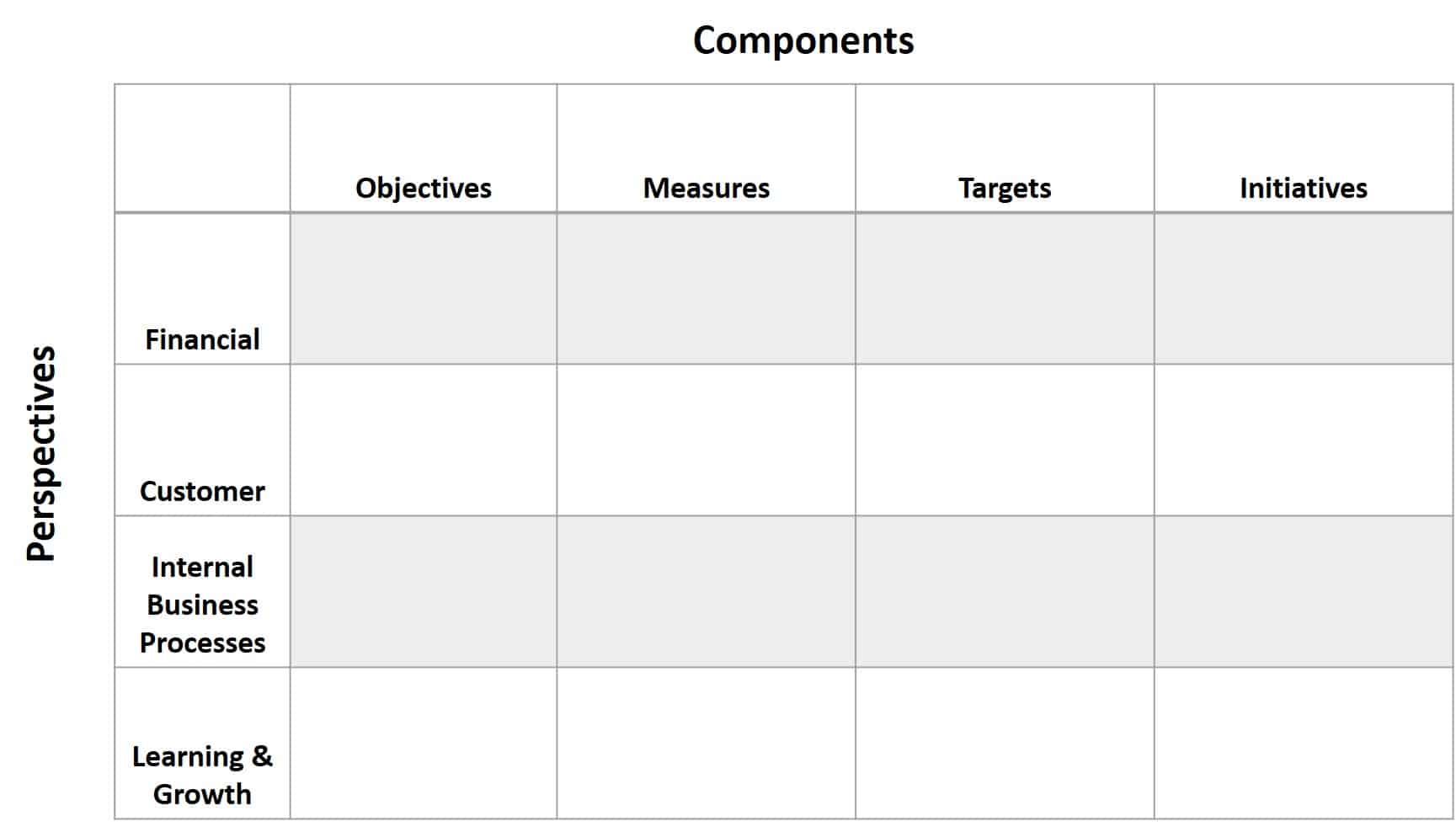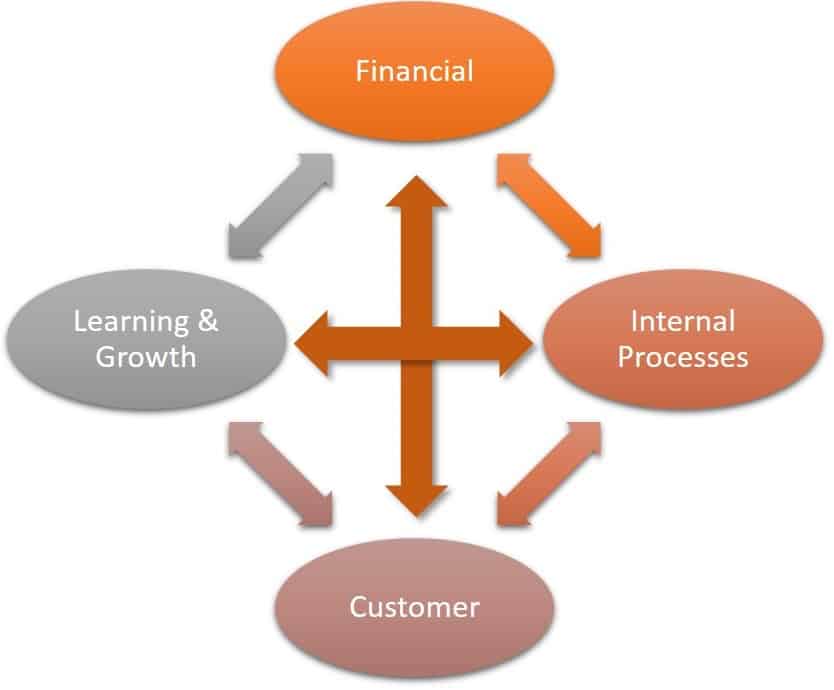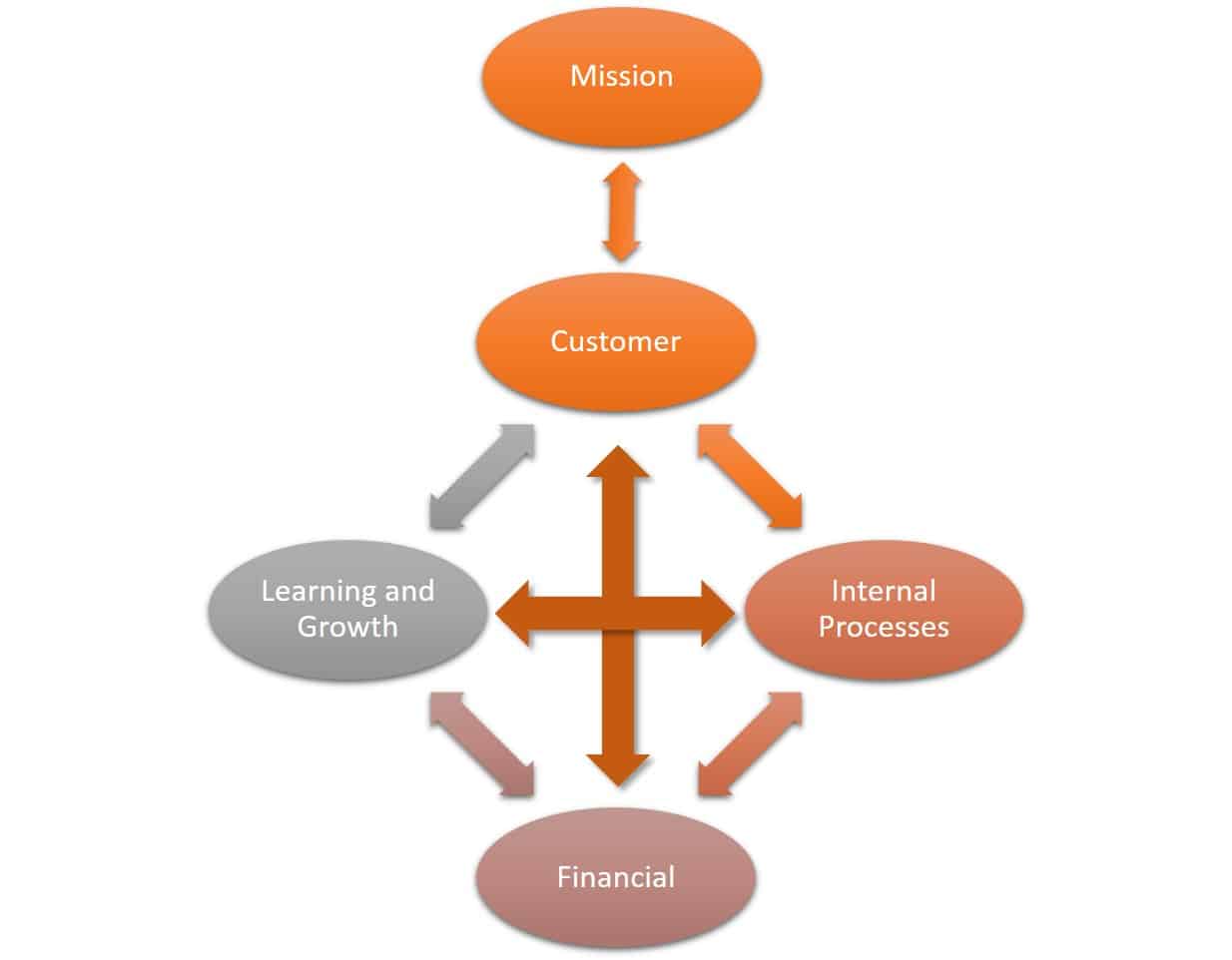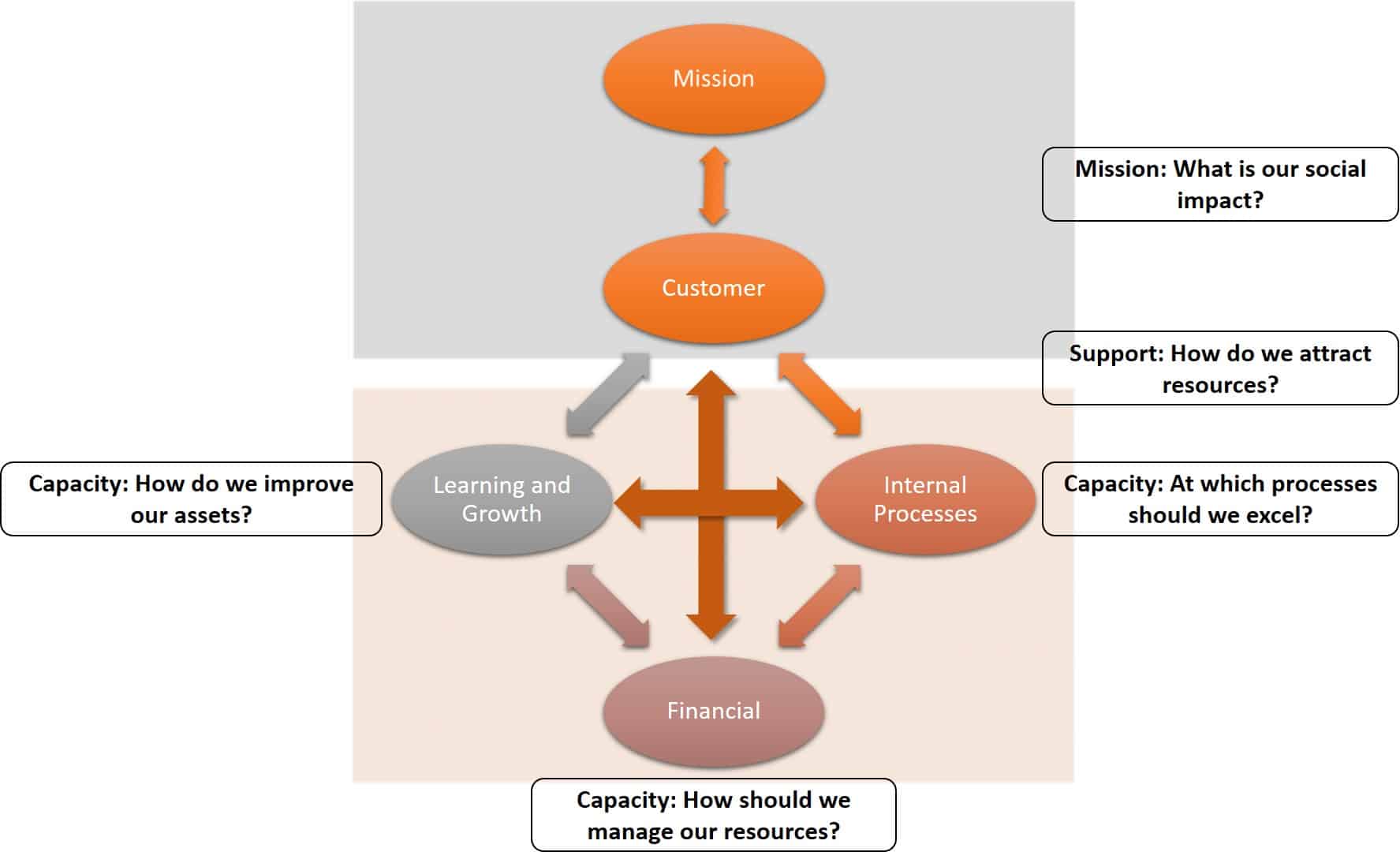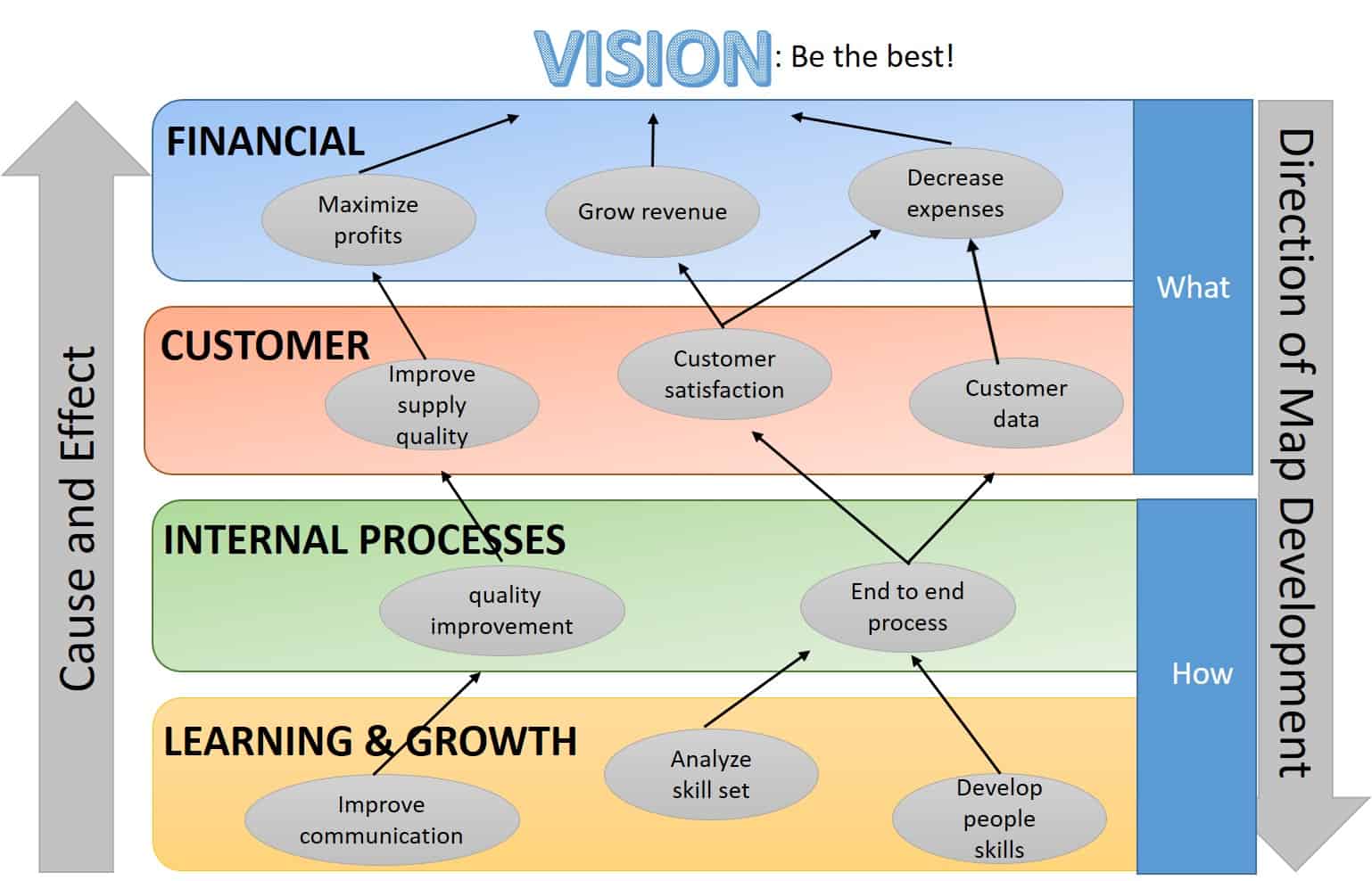What Is a Balanced Scorecard?
A balanced scorecard (BSC) is a management system that combines all of your company’s strategic objectives and metrics into a single document. It is a loosely structured report that allows for a company’s unique design and content specifications. Describing the high-level strategies and lower-level tactics in a meaningful way, the BSC can act as a daily guide.
The scorecard itself contains four separate perspectives: financial, customer, internal business processes, and learning and growth. These perspectives look at your objectives, measures, targets, and initiatives from the point of view of your bottom line, your customers, your processes, and your staff development. Inextricably connected to one another, the four perspectives provide you with a holistic picture of your business’ health. Below, you’ll find a plain, standard version of the BSC that you can take and customize. A general online search for balanced scorecards should yield a vast field of examples, each tailored to reveal the personality and needs of the company that produced it.
You will use key performance indicators (KPIs) to help guide your BSC progress. KPIs are your BSC measures, and you set your targets to reflect your goals. KPIs track employee performance of the initiatives that lead to your long-term strategic objectives. Some examples of KPIs in each perspective are:
- Financial: Total asset holdings, profitability of net assets, cash flow, and total expenses
- Customer: Average annual sales volume per customer, percent market share, and customer satisfaction
- Internal Business Processes: Average decision-making time, number of properly executed orders, and average time from order to completion
- Learning and Growth: Research and development expenses, average cost of employee training, and trust rate of employees in the company
The goals of the BSC are similar to those of any performance-measuring system. The goals of the BSC include:
- Improve the overall perception of performance management
- Get employee buy-in for developing and using measures
- Develop a workforce that chooses and uses measures wisely
- Decrease the time it takes to go from choosing to using a measure
- Improve the current operational measures to reflect the strategic objectives
There are many benefits to employing a BSC. Of course, the biggest benefit is getting your full staff to realize your company vision. Once you attain this, you can realize your expected financial results with aligned KPIs. Further, your BSC can help sell your ideas to investors. A BSC shows that you have thought through your ideas and strategy — even down to the granular level. Additional reasons for a BSC include:
- To Tell a Story: Strong scorecards help you tell the story of how you’re balancing your complex set of variables. Your stakeholders know that you have a picture unblemished by special interests.
- To Enhance Staff Performance: When you give your staff consistent, concrete feedback, it helps them excel. All staff perform better when they know what they’re doing and what they need to improve.
- To Implement Your Strategy: A BSC puts your strategy into understandable actions for everyone, taking your goals from the nebulous, high level to the tangible, detailed level.
- To Develop the Right Measures: Measures developed in a bubble seldom bring about the results that you need. You can achieve the required focus and development by purposely developing the logical structure inherent in a BSC.
- To Balance Performance: A BSC lives up to its name - it keeps you balanced. It should strike the right balance for your organization between the strategic goals and the operational performance.
- To Eliminate Holes: Developing measures without a strategic plan or developing a strategic plan without measures creates gaps. The structure of the BSC enhances your view of these gaps and fills in any key, missing factors.
- To Improve Management: With a BSC, you can easily observe the measures in even the most complex organization. When you present performance measures in such a high-level document, you can more effectively monitor and correct problems.
You can use a BSC in the private and public sectors. Although it was originally developed for the private sector, professionals have adapted it for the public sector as well. For commercial, private-sector companies, the financial perspective is necessarily the highest requirement, even though you subsidize that perspective with the other three interrelated perspectives. For the public sector, a mission-support-capacity framework is more appropriate. This adaptation focuses on the customer perspective and adds mission as an additional perspective from the customer viewpoint. We measure public organizations by how well they meet the needs of their constituents. The financial perspective is still a perspective requirement, it is lower priority here. The customer (also known as the constituent) is the priority in the public sector.
Private-Sector Perspectives
Public-Sector Perspectives
Expanding on the public-sector perspective, you categorize the framework by mission-support-capacity. Per the graphic above, this mission-support-capacity framework asks questions to maximize of social impact for each perspective. The key features of a BSC for the public sector include:
- A redesign that focuses on service
- Links between strategy, an organizational culture, and difficult resourcing
- A framework that cuts across organizational boundaries
- A document that reflects the change to a culture of improvement, learning, and innovation
What Is a Strategy Map?
In the BSC process, you can overlay your company’s strategic objectives with a strategy map. You design the strategy map either during the development of your objectives or directly after. This strategy map points out how your objectives are linked. It can also be used as a stand-alone tool to communicate your overall strategy. Essentially, the strategy map is the objectives portion of your BSC with built-in direction. It shows what you want to accomplish through the objectives of the financial and customer perspectives. Then, it illustrates how you will accomplish your goals through the objectives of the internal business processes and learning and growth perspectives.
The Challenges of Strategic Planning
Strategic planning is the planning exercise during which you and your company define your direction or focus and allocate resources in order to accomplish them. A strategic plan should include your organizational goals, actions to produce results, and indications of success. However, producing a strategic plan is challenging. It is easy to build a plan that fails. A good strategic plan will achieve your desired results and improve your business. To do so, you need a solid planning process, a firm understanding of your environment, consensus from your group, and a willingness to be flexible. Reasons why strategic plans fail include:
- Having the wrong people involved in the planning group
- Writing a plan and not using it
- Having poor leaders in place
- Ignoring the current market situation
- Being unrealistic or unfocused with your goals
- Not following through on the plan
- Making only a partial commitment
Strategic planners outline these additional ways to make the process easier:
- Use comprehensive tools to help draft a plan and track its results
- Use a BSC that tracks complex KPIs in one place
- Use a system for strategy management that works smarter
- Use a system that connects employee goals with the overall strategy
After looking at how you can build a BSC, you should follow these recommendations to ensure that you are reaping the optimal value from your scorecard and development process:
- Use the Most Updated Scorecard Model: The most recent version of a BSC will work for any organization, from private to public. It will also include supporting documentation, such as the strategy map that explains your hypothesis and direction.
- Automate Your Model: Software can save you from extra work. Linking your BSC to live data ensures it is constantly monitored and updated.
- Connect Your Model: Ensure that you are not developing dead ends. Do this by making sure that all goals on your map contribute to other goals. Moreover, your goals should be top-down, from your finance (or customer) perspective down to your learning and growth perspective.
- Choose the Best Metrics: Your KPIs should relate directly to your strategy. Also, make sure that you are not mixing operational and strategic KPIs. You can always put operational KPIs in a separate BSC or cascade the BSC to another department or person. Lastly, design your KPIs to be leading rather than lagging. This way, you can manage the situation rather than react to it.
- Use Low Maintenance Software: Be sure to use software that requires minimal maintenance. If there are broken links in a program such as Excel, you must continually update them so that your sheet works, especially if you have external users.
How to Build a Balanced Scorecard
If you have already reviewed the companion article on the balanced scorecard, then you fully understand what a BSC is and why you need it. Also, you probably already have a general idea about what you’re going to pull together to start developing a BSC for your company. In the next two sections, we outline the step-by-step processes to build a BSC. First, we will discuss what it takes to create a generic commercial BSC. Then, we will list the steps to generate a BSC for the public sector.
The Generic Commercial Balanced Scorecard
You can use a generic BSC for any commercial or private company and any department within that company. Remember, you can have a BSC that assesses your entire company and others that trickle down (from the overarching document) to individual departments. Here are the basic steps for creating a generic commercial BSC:
- Develop a purpose statement. Look outward for this. Your purpose statement should consider three main issues: what your company plans to do, what advantage you bring to the marketplace, and your scope.
- Create and record an agenda of change. What are some improvements you’re hoping to make? What tasks and relationships can you leverage to help with that change? What makes sense with your strategy?
- Develop your strategy map. For more information, see the “What Is a Strategy Map?” section in this guide.
- Develop your metrics. Your metrics are your KPIs. These help you figure out what is working for your company and what needs improvement.
- Develop your initiatives. These projects bring your strategy to life. What are the projects that drive your strategy? Be sure to review the ones that do not align with your strategy to see if you need to amend or end them.
The Public-Sector Balanced Scorecard
The public-sector scorecard works a little differently than the commercial one. Many public- sector organizations have little to no competition in their marketplace, as they offer truly unique services. However, in many ways, public-sector companies face considerably more challenges than commercial companies do. For example, because they report to elected officials (who are not permanent), there can be frequent changes in direction or funding. Further, it can be difficult to rally your team behind a new strategy because your ability to compensate them is limited. Here are the basic steps for creating a public-sector balanced scorecard:
- Get stakeholder buy-in. You should establish buy-in at every level and have a broad team base with champions in every part of your organization. Everyone, including your management team, needs to know what to expect. If necessary, perform a political, economic, social, and technological (PEST) analysis or a strengths, weaknesses, opportunities, and threats analysis (SWOT). This will help you realize success in your current environment. Develop the necessary communication and training plans according to your employee bargaining agreements.
- Decide on your strategy elements in your four perspectives. Start with your customer perspective, not your financial perspective.
- Develop your performance measures (KPIs).
- Develop your initiatives.
- Apply a performance-measurement system.
- Cascade your highest-level scorecard down through your departments and teams. You can take this as far down as needed.
- Evaluate your scorecard. Additionally, look at how you’ve implemented it in your company.
- Develop a report of your scorecard implementation. Make changes as necessary.
- Determine archive periods. We recommend quarterly archiving.
Other Common Types of Balanced Scorecards
The main types of balanced scorecards are for private and public companies. If you would like to customize your BSC further, there are many dedicated template types available. Some examples include the following:
- The CEO BSC: This template includes strategy execution and performance-measurement systems as well as very general objectives and KPIs.
- The Customer Service BSC: A template that focuses on customer service should not only align with your overall business strategy, but should look at your current customer service model and its problems.
- The Marketing BSC: A marketing scorecard should reflect customer retention rate (customer perspective), the cost per service encounter (financial perspective), and the conversion rate per sales channel (business processes perspective). You could also tailor this BSC to content marketing. Content-specific KPIs would include the number of sales referred by your content and the number of support tickets from your content.
- The HR BSC: This scorecard should focus on managing your talent and ensuring it is up to date with the current trends. Nowhere in your company do evolving attitudes become more relevant than in your HR department. Factors to consider include current economic wages, the current attitude toward inclusion, and any other factors that play into talent supply and demand. HR professionals should be proactive, not reactive. Experts have listed ten standard KPIs as a starting place for you to construct your own. These include:
- Hiring speed
- Hiring quality
- Six-month new-hire performance
- Per employee profit
- Employee productivity before and after training (percent difference)
- Time to productivity
- Profit per employee
- Voluntary turnover
- Involuntary turnover
- Involuntary and high-performing turnover
- The IT BSC: The scorecard for IT has to be highly capable of identifying upstream issues before they come to fruition. The KPIs for IT do not necessarily reflect revenue, but show the expenses that the department incurs within your company. Examples of these KPIs include IT expenses as a percentage of the total expense and support expense per user. The customers for this scorecard are external and internal.
- The Sales BSC: A BSC is ideal for boosting sales performance because it will help you identify and focus on the key elements that make your sales operations successful. In this scorecard, you should address how you go from initial requests to closing sales. This is a conversion process, and examples of KPIs are the total cost to gain a new customer in dollars, and the customer lifetime value in dollars. You would also want to look at how your team is performing, with a metric like revenue per sales rep in dollars.
- The Hotel BSC: In the hospitality industry, the BSC metrics give hotel management meaningful feedback. Important characteristics of this industry include service, management of stock, marketing, and production. Examples of KPIs include percent revenue per room growth, percent flow-through index, the guest satisfaction score, and percent associate turnover.
- The Energy Production BSC: The energy sector takes into account longstanding best practices and new sustainable strategies. This industry is currently in a state of transition, with a major business model transformation expected by 2020. Fueling this prediction are climate changes, resource scarcity, and new technology. Large businesses are beginning to focus on reducing their carbon footprint and using green electricity. Given this concentration on sustainability and renewable energy, examples of metrics could include total shareholder return, greenhouse gas emissions, and percent of energy produced by renewable sources.
- The University BSC: Higher education balanced scorecards fall under the same category as nonprofit scorecards. The architecture here emphasizes the role of mission and reduces the influence of financial indicators. For universities, the BSC makes sense because it can standardize measures across all the different departments. In terms of university metrics, we could consider an indicator like student outcomes, including involvement in the larger community, overall satisfaction with life, and motivation as lifelong learners. You can also evaluate the comprehensiveness of teaching materials and your instructors’ qualifications.
- The Dental Practice BSC: In a dental practice, a balanced scorecard may seem like overkill. However, a substantial number of dentists run private practices that have a larger scope than anyone expects. Running these businesses in a streamlined, effective manner keeps dentists from falling victim to local economic ebbs and flows. Many dentists cannot determine the strategic measurements to get themselves started. In addition, many dentists tend to focus on the finance, not the customer perspective. A BSC can restore the balance that these professionals need. Examples of KPIs for dental practices include new patients per month/year, case acceptance rates, and cancellation and no-show rates.
- The Nonprofit BSC: In this guide, we have already covered nonprofit scorecards. The main takeaway from this discussion is that the nonprofit BSC leads with the customer perspective, not the financial perspective. However, the customers in this scenario are not just the end users of your product and service, but also your partners and any other third parties with a stake. Your customers are those who make donations and those who benefit from your existence. A nonprofit BSC helps your company speak in the same language as your funders.
- The Employee Engagement BSC: Employee engagement refers to an employee’s level of enthusiasm for and emotional attachment to their job. This is not the same as their satisfaction, general happiness, or motivation. Employee engagement and business performance go hand in hand. Improved engagement results in huge cost reductions. To measure this engagement, you should show a direct correlation with performance outcomes.
The Balanced Scorecard for Startups
A startup is a company in its early phase of development. Startups are small and usually financed by either their founders, investors, or a single person, and are designed to scale quickly. They differ from small businesses in that they can grow without the limitation of their geography. Many of these companies are continuously seeking new capital. Therefore, their business model, their expected financial outcomes, and the manner in which they spend their venture capital are all under constant scrutiny. This means that many startups are hyper-focused on their finances and product and, thus, much less focused on their customers.
With a lean staff constantly multitasking at warp speed, a startup has little time for paperwork and formalizing business processes. However, making time for a BSC is critical. A BSC crystallizes your strategy not only for your staff, but also for your investors. It takes your business model one step further and effectively demonstrates to your investors how you will accomplish your objectives. It also lets them know when they can profit by making larger investments and if your team is ready to solve your initial customer problem.
The Four Perspectives of the Balanced Scorecard through the Startup Lens
In the context of a startup, the four BSC perspectives include the following considerations:
- Financial Perspective: Be sure to articulate that you are still looking for investments and that you have recently started this company. You should include what you expect of your financial outcomes. You should also indicate when you expect your company to be in the black financially.
- Customer Perspective: Many startups struggle with this perspective. This is because startups spend the majority of their time developing their product and service. Many forget that third-party partners can often help provide support for things the startup cannot accomplish on its own.
- Internal Business Processes: After you’ve completed all the work on the customer perspective, the processes perspective should follow naturally. Many startups forget the cause-and-effect linkages between processes and delivering your promises to your customers.
- Learning and Growth: When it comes to staff skills and expertise, startups are highly niche-oriented. Some of the workforce even goes the extra mile to learn or perform tasks outside of its skill set. For example, one startup HR manager recounted stories of his accountant learning to debug the company software to help his team in a crunch. In this perspective, you should identify the specific areas in which you need expertise.
Additional tips for startup BSCs include:
- Detail for your investor(s) what your company’s financial success looks like.
- Start your BSC with your financial indicators and market numbers.
- Put your key business goals on your strategy map. Keep it simple and high level to start.
- Provide more information (not less) about your spending plan and your plan to achieve each goal. Include a financial breakdown.
How to Track Your Balanced Scorecard
Many organizations start by tracking their scorecard in Microsoft Excel or PowerPoint. Excel is a generally ubiquitous program that small businesses can use to create quick tables and charts. PowerPoint can also be a good option because it lends itself to executive presentations and is simple to use. However, these programs may not be the best sustainable option. Further, if you need to scale, Excel is not your best bet.
Enterprise Resource Planning (ERP) software is another option for tracking your scorecard. Many companies, such as Oracle, SAS, and SAP, already have ERP software in house. Many of these have built-in BSC modules. However, the configuration and integration of these modules can be costly and time consuming. Moreover, you would have to perform the upkeep and management internally, and, as your BSCs evolve, your IT team would have to constantly develop workarounds.
So, what is the best way to manage your BSC? Many experts say that an application specific to the BSC is critical and the most cost-effective answer. Without a designated application, the following might happen:
- One-to-two employees will spend too much time generating management reports.
- You will have problems with version control.
- Your data will not add up because the formulas constantly need to change.
- Your reports will be disorganized, and your team will spend more time interpreting them than they will talking about the business issues at hand.
- You will need to rebuild your reports every quarter or month.
Managing your BSC online with a specific application is easier than you think. The following are tips to ease BSC management:
- Start with building the basics of your scorecard(s) before you put it in your program.
- Add the detailed information to your BSC in your software. Determine who is responsible for the data, how much data is necessary, where the data will come from, and how the cause-and-effect will happen.
- Use your software to create repeatable processes.
- Manage your software. This includes your reporting calendar, measures, projects, and KPIs. KPI owners should update their own KPIs. Determine quarterly overviews that tell one main story.
- Send out the report prior to meetings.
How to Choose the Right Balanced Scorecard Software
So far, we have reviewed a few programs that can help you track your BSC. However, these may not capture what you need, especially if you have to scale up or make changes. Templates are fantastic resources to get you started, but there are many platforms on the market that get you started and keep you running. The functions of these packages include helping you to develop and track the following:
- Strategy maps
- KPIs
- Access rights
- Visualization of Organizational Structure
- Dashboards
- Knowledge base access
- Performance reports
To find an appropriate software package, it’s fine to perform a basic search of the available software, pick one, and implement it. Still, there are features other than availability to consider. These include:
- Pricing: There are many different levels to consider. Some are free, and many are low-cost, monthly options.
- View-Only Users and Collaboration: Who in your organization and in your partners’ organizations needs to have access? What kind of access can you grant them?
- Seamless Integration: What programs do you have now? Can your BSC program integrate with them without a lot of work-arounds and extra expense?
- Customer Support: If you have questions and issues, you should have answers and fixes.
- Ready for Use: Plug-and-play are the easiest programs to use, so the learning curve should not be steep. Your business users should own this software and not need to call in IT every time you have a change.
- Capacity to Develop Private and Public Scorecard: You never know what type of BSC you will need to develop. Your program should be able to handle anything with maximum efficiency.
- Search Functionality: Your BSCs should not live in a bubble. They should be easy to locate when needed.
- Alert Subscriptions: Alerts keep you and your business on track and functioning, so you can be proactive regarding problems, not reactive.
- Mobile Enabled: In today’s world, everything should be available in the mobile environment. If you live in a mobile world, your BSC program should live there as well.
- Training: Even if your software requires only a minimal learning curve, your staff should still have access to additional training to help them maximize your investment.
- Specific Functionality: It is essential that you choose software that’s right for your organization. Want to test it? Find your most complicated KPI and ask your vendors to model it in their software. Just this test can save your company millions of dollars.
“My experience with balanced scorecard software was in choosing, implementing, and using it in past staff-level government jobs. My management education comes in handy when I combine it with my military and government experience. I have found the balanced scorecard helpful in many different areas of focus: aviation, logistics, and corps-level staff positions. It helps us to ensure we are capturing the strategic needs as well as the lower-level details, especially when we cascade it down through the units. The software is helpful for the design of the scorecard and for keeping me and my staff abreast of any needed changes. I can quickly send copies and reports to my superior officers and any other interested parties without putting any undue pressure on my staff.
“For my profession, the critical features of the BSC are its accessibility and ease of use. Working in government environments means that the safety and security of our data is an absolute must-have. Programs that we can easily integrate into this environment are worth a lot to us and get us up and running quickly. Since my staff turns over very frequently (every one to two years), I need a program that they can quickly come online with and not struggle to understand.
“I would advise other professionals, whether in government service or not, to choose software that immediately speaks to them and that they can use to make the scorecard right for their business. This means that they understand it with minimal learning. There are so many options out there! I cannot justify spending days and weeks working to learn a new product when there are user-friendly options. The software should also give you a scorecard that is unique — as they all are — in look and feel and works for your team.”
Manage Your BSC in Smartsheet to Gain Actionable Business Intelligence
Empower your people to go above and beyond with a flexible platform designed to match the needs of your team — and adapt as those needs change.
The Smartsheet platform makes it easy to plan, capture, manage, and report on work from anywhere, helping your team be more effective and get more done. Report on key metrics and get real-time visibility into work as it happens with roll-up reports, dashboards, and automated workflows built to keep your team connected and informed.
When teams have clarity into the work getting done, there’s no telling how much more they can accomplish in the same amount of time. Try Smartsheet for free, today.
